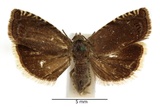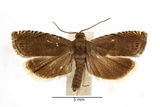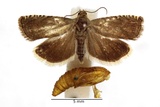Cydia nigricana (Fabricius, 1794) Species
Last modified: Dec. 15, 2023, 11:10 a.m.
A fairly common species in the northern part of Belgium, much rarer in the south. Can be locally a pest on various Leguminosae, especially on cultivated peas.
Details
- Classification
- Family: Tortricidae > Subfamily: Olethreutinae > Tribus: Grapholitini > Genus: Cydia > Species: Cydia nigricana
- Vernacular names
- Erwtenbladroller (NL), Pea Moth (EN), Erbsenwickler (DE)
- First mention in Belgium
- De Crombrugghe G. 1906a. Catalogue raisonné des Microlépidoptères de Belgique. — Mémoires de la Société entomologique de Belgique XIII: 1–172; XIV: 1–155. On page 138.
- Status
-
Native
Distribution
Imago
Wingspan 11–16 mm. Fairly uniform brown or grey-brown, finely irrorate with pale ochreous distally, conspicuous costal strigulae, weakly developed ocellus with 3 or 4 black dashes and is edged plumbeous. Hindwing with white or cream-white cilia which contrast strongly with the dark fuscous coloration of the wing.
Egg
Eggs laid in clusters on leafs. Oval shaped, 0.75 – 0.8 mm in length, flattened on one side. Initially white coloured, becoming yellow with age.
Caterpillar
The final instar reaches 14 mm in length. The caterpillar is initially whitish but becoming yellow. Eight lines of dark warts are present. The head is light brown to dark, the nape and anal shield are grey-brown, the former has dark dots on the sides and back.
Bionomics
The larvae living in a pod of the food plant, feeding on the green peas. They move from seed to seed, often uniting two together with a silken web. When it's fully fed, it cuts a hole in the side of the pod and drops to the ground. Here it constructs a cocoon in the soil where it hibernates.
They are active during afternoon sunshine and as well at dusk and night when they come occasionally to light.
Flight periods
The adults have been seen from late April towards late August, with the peak in May and June.
Observed on
- Host plant (species):
- Pisum sativum
- Host plant (genera):
- Vicia and Lathyrus
The species is often considered a pest in pea pods, but it also lives in the pods of other legumes. The larvae living on Pisum sativum, Lathyrus japonicus, Lathyrus pratensis, Lathyrus odoratus, Vicia cracca, Vicia sativa and Lens culinaris.
Habitat
It inhabits rough ground, herb-rich pastures and fields and especially gardens and horticultural land where peas are cultivated.



